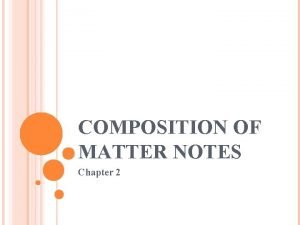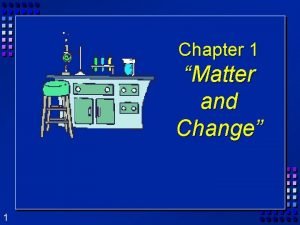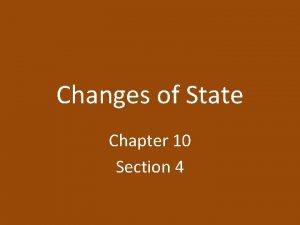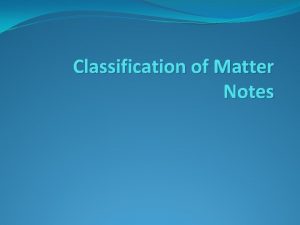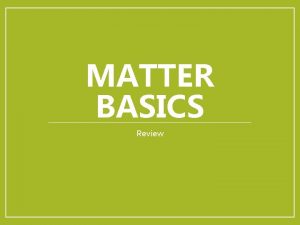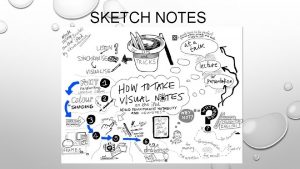Review Notes 9 Matter What is Matter Matter











- Slides: 11

Review Notes #9 Matter

What is Matter? • Matter is anything that takes up space. • That space is called volume • Building blocks of matter are elements. • Smallest part of an element is an atom.

Structure of The Atom • 3 particles make up an atom. • Proton – in nucleus, positive charge, mass of 1 amu. • Neutron – in nucleus, neutral charge, mass 1 amu. • Electron – outside nucleus, negative charge, no mass.

Compounds and Periodic Table • A compound is formed from two or more elements. • Elements are arranged on the periodic table by atomic number • Sorted by characteristics.

Phases of Matter • Solid – particles are close together, slow moving, definite volume and shape • Liquid - Particles further apart and moving a little faster. Definite volume but not shape. • Gas - Particles very far apart and moving very fast. No definite shape or volume.

Phase Changes • Melting – Solid to Liquid, energy absorbed • Freezing – liquid to solid, energy released • Vaporization – liquid to gas, energy is absorbed. • Condensation – gas to liquid, energy is released • Water – boiling point 100 o. C, freezing point 0 o. C

Solutions • A mixture that stays evenly distributed like salt water. • Salt is soluble in water. Sand is insoluble in water • Things that cause a faster dissolving rate are, stirring, increase in temperature, and smaller particles.

Density • Density equals mass divided by volume • Every material has a different density • No matter how small that sample of a material may be the density is the same. • Less dense objects float on more dense objects.

Physical/Chemical Changes • Physical Changes alters the appearance of an object, like size and shape • EX. Ripping paper • Chemical changes create a new substance. • EX. Burning paper • Energy is always added or released.

Physical/Chemical Properties • Physical properties describe an object with observations not inferences. • EX. The chair has 4 legs, not the chair is ugly. • Chemical properties describe the characteristics of a substance. • EX. Flammable

Conservation • The law of conservation of matter. • Matter can not be created or destroyed. • It can only be converted into a different substance.
 Facteur g
Facteur g Composition of matter notes
Composition of matter notes Chapter review motion part a vocabulary review answer key
Chapter review motion part a vocabulary review answer key Ap gov review final exam review
Ap gov review final exam review Narrative review vs systematic review
Narrative review vs systematic review Inclusion criteria examples
Inclusion criteria examples Narrative review vs systematic review
Narrative review vs systematic review Chapter 1 review matter and change
Chapter 1 review matter and change Chapter 10 review states of matter section 4
Chapter 10 review states of matter section 4 Classification of matter vocabulary review
Classification of matter vocabulary review Classification of matter section 1 composition of matter
Classification of matter section 1 composition of matter Grey matter of nervous system
Grey matter of nervous system

